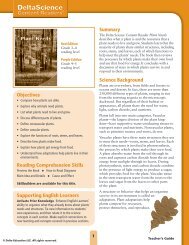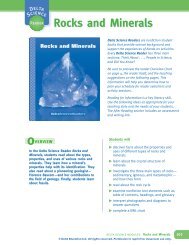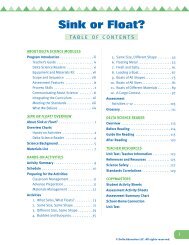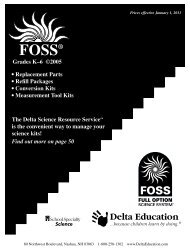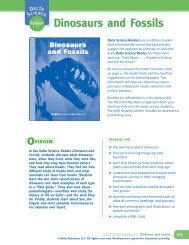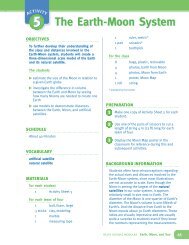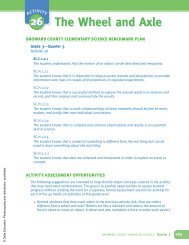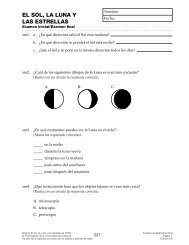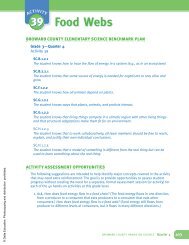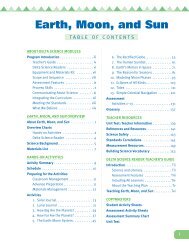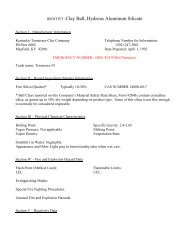37. Push and Pull - Delta Education
37. Push and Pull - Delta Education
37. Push and Pull - Delta Education
Create successful ePaper yourself
Turn your PDF publications into a flip-book with our unique Google optimized e-Paper software.
activity<br />
37<br />
<strong>Push</strong> <strong>and</strong> <strong>Pull</strong> *<br />
BROWARD COUNTY ELEMENTARY SCIENCE BENCHMARK PLAN<br />
Grade K—Quarter 4<br />
Activity 37<br />
SC.C.1.1.1<br />
The student underst<strong>and</strong>s that different things move at different speeds.<br />
© <strong>Delta</strong> <strong>Education</strong>. Photocopying <strong>and</strong> distribution prohibited.<br />
SC.C.1.1.2<br />
The student knows that there is a relationship between force <strong>and</strong> motion.<br />
SC.C.2.1.1<br />
The student knows that one way to change how something is moving is to give it a push or a<br />
pull.<br />
SC.H.1.1.1<br />
The student knows that in order to learn, it is important to observe the same things often<br />
<strong>and</strong> compare them.<br />
SC.H.1.1.2<br />
The student knows that when tests are repeated under the same conditions, similar results<br />
are usually obtained.<br />
SC.H.1.1.4<br />
The student knows that people use scientific processes including hypotheses, making<br />
inferences, <strong>and</strong> recording <strong>and</strong> communicating data when exploring the natural world.<br />
*indicates Scientific Method Experiment<br />
ACTIVITY ASSESSMENT OPPORTUNITIES<br />
FOR PERSONAL USE<br />
The following suggestions are intended to help identify major concepts covered in the activity<br />
that may need extra reinforcement. The goal is to provide opportunities to assess student<br />
progress without creating the need for a separate, formal assessment session (or activity) for<br />
each of the 40 h<strong>and</strong>s-on activities at your grade.<br />
1. Ask students to complete the following sentences by choosing the correct word. “To pull a<br />
very heavy tree branch, you must use (more/less) force than if you are pulling a lighter<br />
branch. To push a lighter child’s chair across a carpet you must use (more/less) force than<br />
if you are pushing a heavier adult’s chair.” Ask, Are these sentences questions or<br />
conclusions? (They are conclusions.)<br />
2. Use the Activity Sheet(s) to assess student underst<strong>and</strong>ing of the major concepts in the<br />
activity.<br />
broward county h<strong>and</strong>s-on science Quarter 4 371
In addition to the above assessment suggestions, the questions in bold <strong>and</strong> tasks that<br />
students perform throughout the activity provide opportunities to identify areas that may<br />
require additional review before proceeding further with the activity.<br />
372<br />
FOR PERSONAL USE<br />
activity 37 <strong>Push</strong> <strong>and</strong> <strong>Pull</strong><br />
© <strong>Delta</strong> <strong>Education</strong>. Photocopying <strong>and</strong> distribution prohibited.
activity<br />
37<br />
<strong>Push</strong> <strong>and</strong> <strong>Pull</strong><br />
OBJECTIVES<br />
Students investigate the relationship<br />
between the weight of an object <strong>and</strong> how<br />
much force it takes to move it.<br />
1 roll tape, masking<br />
*provided by the teacher<br />
DSR How do we learn?<br />
© <strong>Delta</strong> <strong>Education</strong>. Photocopying <strong>and</strong> distribution prohibited.<br />
The students<br />
observe that the motion of an object can be<br />
changed by applying force—a push or a<br />
pull<br />
predict that it takes more force to move a<br />
heavy object than to move a light object<br />
compare the amount of force needed to<br />
move objects of different weights<br />
conclude that the heavier the object, the<br />
more force it takes to move it<br />
SCHEDULE<br />
About 50 minutes<br />
VOCABULARY<br />
experiment<br />
force<br />
FOR PERSONAL USE<br />
MATERIALS<br />
For each student<br />
1 Activity Sheet 37, Parts A <strong>and</strong> B<br />
For the class<br />
6 boxes, closeable, all the same<br />
size*<br />
objects to place in 4 of the boxes,<br />
so that 2 are moderately heavy<br />
<strong>and</strong> 2 are very heavy*<br />
PREPARATION<br />
1<br />
2<br />
3<br />
4<br />
Make a copy of Activity Sheet 37, Parts A<br />
<strong>and</strong> B, for each student.<br />
You will need six boxes, all the same size,<br />
that can be closed to hide their contents.<br />
The boxes should be large enough that<br />
students will need to use some effort to<br />
move the heaviest ones. Check with<br />
grocery stores or supermarkets for boxes.<br />
You might want to call ahead <strong>and</strong> ask<br />
them to save some for you. Alternatively,<br />
boxes that hold reams of paper can be<br />
used.<br />
Find objects (or materials) to fill four of<br />
the boxes. Two of the four should be very<br />
heavy <strong>and</strong> require a strong push (or even<br />
two students) to move them. You might try<br />
filling these with books. The other two<br />
should be not as heavy <strong>and</strong> require<br />
noticeably less force to move—but more<br />
force than the empty boxes.<br />
Set up two “Move It!” stations in the<br />
classroom (or hallway or cafeteria—you’ll<br />
need space <strong>and</strong> a smooth, flat surface<br />
over which to slide the boxes). Place three<br />
boxes at each station: one empty<br />
(lightweight) box, one heavier box, <strong>and</strong><br />
one very heavy box. Also at each station,<br />
place two strips of masking tape about 10<br />
feet apart, <strong>and</strong> line up the boxes along<br />
one strip. Students will push (or pull) the<br />
boxes across the floor to the other strip.<br />
broward county h<strong>and</strong>s-on science Quarter 4<br />
373
P<br />
BACKGROUND INFORMATION<br />
All around us, objects are in motion. They roll,<br />
slide, spin, <strong>and</strong> fall. They move in straight<br />
lines, back <strong>and</strong> forth, or around <strong>and</strong> around in<br />
circles. They move at different speeds <strong>and</strong> in<br />
different directions.<br />
All objects require a force—a push or a pull—<br />
to set them in motion. The stronger the force,<br />
the farther <strong>and</strong> faster an object will move.<br />
Likewise, the heavier the object, the more<br />
force it takes to move it.<br />
Students will come to the latter conclusion by<br />
conducting an experiment. An experiment is a<br />
scientific investigation that helps solve a<br />
problem. Not all experiments follow the same<br />
steps, but most can be summarized by asking<br />
a few simple questions:<br />
1. What do you want to find out?<br />
2. What do you think will happen?<br />
3. What did you observe?<br />
4. What can you conclude from your<br />
observations?<br />
In this activity, students will follow these<br />
steps as they explore the relationship<br />
between the weight of an object <strong>and</strong> the<br />
amount of force needed to move it.<br />
FOR PERSONAL USE<br />
374 activity 37 <strong>Push</strong> <strong>and</strong> <strong>Pull</strong><br />
Activity Sheet 37, Part A<br />
<strong>Push</strong> <strong>and</strong> <strong>Pull</strong><br />
1. What is a good title for the experiment? Circle<br />
your choice.<br />
Force <strong>and</strong> Weight<br />
Kinds of Boxes<br />
2. Circle the sentences that are true.<br />
Boxes are moved the same distance.<br />
Boxes are moved different distances.<br />
Boxes are the same weight.<br />
Boxes are different weights.<br />
3. Which box was hardest to move? Circle your<br />
answer.<br />
Light Heavy Very<br />
Heavy<br />
Activity Sheet 37, Part B<br />
<strong>Push</strong> <strong>and</strong> <strong>Pull</strong><br />
4. What can you conclude from the experiment?<br />
Choose a word inside the box. Write the word in<br />
the blank.<br />
You need<br />
more<br />
more<br />
less<br />
force to move heavier objects.<br />
5. Look at the pairs of objects. Which object takes<br />
more force to move? Circle your answer.<br />
© <strong>Delta</strong> <strong>Education</strong>. Photocopying <strong>and</strong> distribution prohibited.
1<br />
Guiding the Activity<br />
Ask students to observe while you open the<br />
classroom door. Ask, What did I have to do<br />
to open this door?<br />
Now shut the door. Ask, What did I have to<br />
do to shut the door?<br />
Additional Information<br />
<strong>Pull</strong> on the doorknob or h<strong>and</strong>le.<br />
<strong>Push</strong> on the door.<br />
© <strong>Delta</strong> <strong>Education</strong>. Photocopying <strong>and</strong> distribution prohibited.<br />
2<br />
Write the words pull <strong>and</strong> push on the board.<br />
Tell students that objects can be moved by<br />
pulling or pushing them. Have students<br />
pretend to pull <strong>and</strong> then to push something.<br />
Then ask them to give you examples of<br />
objects that are moved by pulling or pushing.<br />
Write their answers in a chart on the board.<br />
Write the word force on the board. Tell<br />
students that a force is simply a push or a<br />
pull. Explain that some objects take only a<br />
small amount of force—a gentle push or<br />
pull—to move. Other objects take a lot of<br />
force—a hard push or pull—to move.<br />
Distribute a copy of Activity Sheet 37, Parts<br />
A <strong>and</strong> B, to each student. Write the word<br />
experiment on the board. Explain that an<br />
experiment is a series of steps that helps you<br />
find out the answer to a problem. Tell<br />
students that in this activity, they are going to<br />
do an experiment that involves pushing or<br />
pulling three large boxes across the floor.<br />
One box is light, one is heavier, <strong>and</strong> one is<br />
very heavy. They are going to compare how<br />
much force it takes to move the boxes.<br />
FOR PERSONAL USE<br />
3<br />
As a class, choose a title for the experiment<br />
from the choices given in step 1 on Part A of<br />
the activity sheet.<br />
Bring students’ attention to the two “Move<br />
It!” stations you have set up. Point out the<br />
light, heavier, <strong>and</strong> very heavy boxes at each<br />
station. Ask, What do you think will happen<br />
when you try to move these boxes?<br />
Examples of objects that are pulled include<br />
a wagon <strong>and</strong> a rope in a game of tug-ofwar.<br />
Objects that are pushed include a<br />
grocery cart <strong>and</strong> a swing.<br />
A suggested title for the experiment is<br />
“Force <strong>and</strong> Weight.”<br />
Guide students to guess that a heavy<br />
object takes more force to move than a<br />
light object does. Emphasize that that their<br />
guess is based on their own experience<br />
with moving things.<br />
broward county h<strong>and</strong>s-on science Quarter 4 375
4<br />
5<br />
6<br />
Guiding the Activity<br />
Next, state that everything in their<br />
experiment will stay the same except for the<br />
thing they want to test. For example, all three<br />
boxes are the same size. All three boxes will<br />
be moved over the same smooth, flat surface.<br />
They are all moved the same distance. They<br />
are all moved by pushing. Help students read<br />
the statements in step 2 of their activity<br />
sheets <strong>and</strong> circle their choices. Then ask,<br />
What is the one thing that will change in<br />
this experiment?<br />
Divide the class into two groups. Have each<br />
group line up behind one set of boxes. Then<br />
give students the following directions for<br />
doing the experiment: Students will take<br />
turns pushing or pulling each box from one<br />
line to the other <strong>and</strong> back again. Have them<br />
pay attention to how hard they must push or<br />
pull each box to get it to move. When they<br />
have finished, ask them to record their<br />
observations in step 3 of the Activity Sheet.<br />
After every student has had a chance to move<br />
the boxes <strong>and</strong> record their observations,<br />
review their results as a class. Ask, Which<br />
box was easiest to move? Which box was<br />
hardest to move?<br />
Now ask students what they can conclude<br />
from this. In other words, what did their<br />
experiment show? Have students choose<br />
their answer in step 4 of the activity sheet.<br />
FOR PERSONAL USE<br />
Have students complete step 5 of their<br />
activity sheet by circling the object in each<br />
pair that they think requires more force to<br />
move.<br />
As appropriate, read or review pages 4, 7, 10,<br />
<strong>and</strong> 15 of the <strong>Delta</strong> Science Reader How do<br />
we learn?<br />
376 activity 37 <strong>Push</strong> <strong>and</strong> <strong>Pull</strong><br />
Additional Information<br />
Help students see that the weight of the<br />
boxes is the one thing that changes in this<br />
experiment. In other words, the only<br />
difference between the boxes is how much<br />
they weigh.<br />
Students should observe that they didn’t<br />
have to push or pull very hard to get the<br />
light box to move. They pushed/pulled<br />
harder to get the heavier box to move, <strong>and</strong><br />
had to push/pull very hard to get the very<br />
heavy box to move.<br />
The light box was easiest to move; the<br />
very heavy box was hardest to move.<br />
From this experiment, students can<br />
conclude that the heavier the object, the<br />
more force it takes to move it (see Figure<br />
37-1).<br />
© <strong>Delta</strong> <strong>Education</strong>. Photocopying <strong>and</strong> distribution prohibited.
Guiding the Activity<br />
Additional Information<br />
Force<br />
Light<br />
© <strong>Delta</strong> <strong>Education</strong>. Photocopying <strong>and</strong> distribution prohibited.<br />
F<br />
Force<br />
Figure 37-1. The heavier the object, the more force it takes to move it.<br />
R EINFORCEMENT<br />
FOR PERSONAL USE<br />
Have students draw or cut out pictures of<br />
objects that take a small amount of force to<br />
move (marble, shoe, swing, toy car) <strong>and</strong><br />
objects that take a lot of force to move<br />
(boulder, automobile, couch, tree).<br />
SCIENCE JOURNALS<br />
Have students place their completed activity<br />
sheets in their science journals.<br />
Force<br />
Very Heavy<br />
F<br />
C LEANUP<br />
Heavy<br />
Empty the boxes <strong>and</strong> either reuse or recycle<br />
them. Remove the tape from the floor.<br />
broward county h<strong>and</strong>s-on science Quarter 4 377
Connections<br />
Science Extension<br />
Have students use small toy cars to prove<br />
that the stronger the force, the farther <strong>and</strong><br />
faster an object will move. Place a masking<br />
tape “starting line” on the floor. Tell them to<br />
push their cars several times, each time a bit<br />
harder than before, <strong>and</strong> to mark with tape<br />
how far it travels each time.<br />
Science <strong>and</strong> Math<br />
As a follow-up to the Extension activity, have<br />
students use a ruler to measure the distances<br />
<strong>and</strong> record them in a chart. Help them turn<br />
their data into a bar graph that shows the<br />
harder the push, the greater the distance the<br />
car traveled.<br />
Science at Home<br />
Invite students to list ten kinds of work they<br />
do at home that involve pushing, pulling,<br />
lifting, or some other force—for example,<br />
pushing the toaster h<strong>and</strong>le, pulling on jeans,<br />
lifting a glass of milk, <strong>and</strong> squeezing the<br />
toothpaste tube. Then combine their lists.<br />
Can the class come up with 100 push-pull<br />
ideas?<br />
Science <strong>and</strong> Language Arts<br />
As an extension to the Science-at-Home<br />
activity above, ask students to keep a<br />
journal—in words or pictures—of the tasks<br />
they used force to do during a one- or twoday<br />
period. For example: “I pushed a friend<br />
on a swing.” “I pulled up weeds in the<br />
garden.” Encourage volunteers to share their<br />
journal entries with the rest of the class.<br />
FOR PERSONAL USE<br />
378 activity 37 <strong>Push</strong> <strong>and</strong> <strong>Pull</strong><br />
Science <strong>and</strong> Social Studies<br />
Show students pictures of the pyramids of<br />
Egypt. Explain that these enormous<br />
structures were built thous<strong>and</strong>s of years<br />
ago, of heavy stone blocks weighing<br />
several tons each. How did the builders<br />
move them into place without the help of<br />
construction equipment? One theory is<br />
that they used rollers, a primitive type of<br />
wheel, to move them up earthen ramps. A<br />
roller works by reducing the amount of<br />
friction between two surfaces as one<br />
object moves over the other. Less force is<br />
needed to move a stone block over the<br />
rollers than to drag it (or carry it) over the<br />
ground.<br />
Provide some wooden dowels for students<br />
to use as rollers to move the heavy boxes<br />
over the floor. Have them push the boxes<br />
with <strong>and</strong> without the help of the dowels.<br />
Can they feel the difference in the amount<br />
of force they need to use?<br />
© <strong>Delta</strong> <strong>Education</strong>. Photocopying <strong>and</strong> distribution prohibited.



